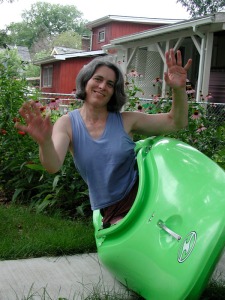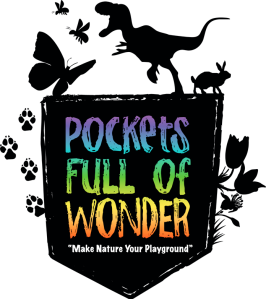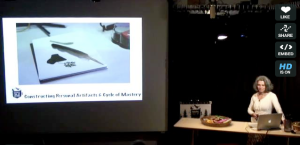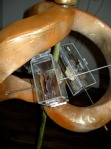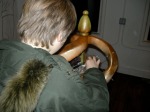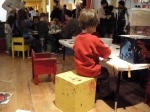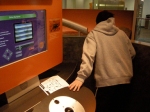Change Management: Community-Based Watershed Management
March 24, 2016
Reimagining Public Participation as a Project Management Approach
Since I last updated this portfolio, I have been to the depths and back exploring the transformative potential of Design Thinking and Service Design for public sector institutions that are guided by 20th century business models and improvement strategies. I have just come up for air.
This journey has been both professionally and personally inspiring. Measured success and self-reflection have strengthened my design practice and provided me with wisdom and insight beyond that gathered through formal education and professional development. I am now prepared to submerge myself once again, this time in organizations primed for this humanist approach to change management.
Influences have been many. As a public servant in Minnesota, I have been fortunate to connect with a broad network of progressive and creative change agents and civically-minded people as mentors and collaborators. As a member of the Service Design Network (https://www.service-design-network.org), I count myself part of an international community of practice second-to-none. And secondary research required for developing community-based watershed management systems has revealed great thinkers and practitioners.
In 2010 I made a commitment to forge my professional aspirations into a more intentional design and program development practice. Expanding my experience in program and policy development with additional graduate training, my practice has become adaptable to a range of public issues in part through my ability to distinguish nuances such as……
- Incrementally improving existing systems versus enabling new systems to emerge;
- Simple and complicated systems versus complex and chaotic ones; and
- The complementary nature of 21st century Design Thinking and Service Design methodology and 20th century Six Sigma, Lean and Kaizen practices.
Some Lessons Learned or Reinforced
Some Outcomes & Impacts (under construction)
Some Samples of Products & Services (under construction)
Some Significant Reflections and Arguments regarding Thorny or Knotty Issues
Compiled Wisdom regarding Thorny or Knotty Issues (under construction)
A Welcome
July 2, 2009
Welcome. In this portfolio you will find interactive objects, fabrications, creative writing, visual arts and documentation related to my service and experience design projects. Scroll through, of course, or view by the categories listed. Enlarge images with a click.
In this image, I am teetering on the the edge of my whitewater kayak, keeping my balance with playful gestures. Since I am always drawn to the dynamism of working in cross-disciplinary teams, and at times, just outside my comfort zone or as a change agent, my work often reflects a similar balancing act. I like to think outside the box.
You will see my fascination with systems and stories and the details that drive them in each project. Over the years, I have combined my skills as a scientist, designer and artist in many ways. Having recently graduated from New York University’s Tisch School of the Arts’ Interactive Telecommunications Program, I intend to use the fields of service design and interactive media and telecommunications, and the principles of play and game design in ways that empower people to express themselves, get things done in satisfying ways and see things with fresh eyes.
I continue to work with children, collaborating with the institutions that nurture them, to bring them closer to nature and the science, art and values it inspires.
I have begun to explore how interactive data visualizations and location-based storytelling might be used to build a community’s or an organization’s capacity to express its identity or tackle difficult issues. (Check out blogroll entries Hans Rosling (amazing), Christian Nold (cool), Jonathan Harris (lovely), Christopher Baker (“theatrical”), and Platial Maps and LoCast (intriguing).)
I look forward to using interactive design to help people and organizations engage in conversations about complex, ambiguous and potentially divisive issues and work creatively to achieve challenging goals.
Enjoy!
Cynthia Hilmoe
315/439-2738
cynthia.hilmoe@nyu.edu
Pockets-Full-of-Wonder: Connecting Kids & Nature
July 2, 2009
A Service Design Project
Pockets-Full-of-Wonder is a system designed to get today’s child outside — an experience designed to make children feel empowered, engaged and inspired by nature. It is an experiment in how technology is best integrated into nature programs designed for digital natives. More details below.
Slide Show: Kids Talk About Pockets-Full-of-Wonder from CD Hilmoe on Vimeo.
Presentation (20 minutes)
Pockets-Full-of-Wonder: Connecting Kids & Nature from CD Hilmoe on Vimeo.
Description
Pockets-Full-of-Wonder is a system designed to get today’s child outside — an experience designed to make children feel empowered, engaged and inspired by nature. It is an experiment in how technology is best integrated into nature programs designed for digital natives.
Pockets-Full-of-Wonder combines field observation gadgets and eGadgets, do-it-yourself kits, pocket-covered apparel, foraging containers, and real-world and virtual community gathering spaces to tap kids’ techie sensibilities and their impulse to play and forage. As with any service design project, the objects and design philosophy are used to elicit intangible effects — in this case, encompassing a child’s experience outdoors interacting with nature. The experience creates lasting memories that form the foundation for a conservation ethic and makes children into confident outdoor adventurers.
Mock-ups and simulations of key components of the system were constructed to elicit reactions from 7 – 10 year olds and their parents and teachers in this proof-of-concept phase of the program development. Applying recent research regarding memory, cognitive development and neuroscience, childhood foraging as well as how boredom and ambiguity drive gameplay, a child-driven program was devised in which unstructured play and transformation are central. Design principles and the experience cycle are used to show what sets the experience apart from more traditional programs. Ongoing development will focus on preparing a production plan; building out the DIY kits; and fabricating eGadget prototypes and coding downloadable programming based on the simulations and mockups.
The project is motivated by a growing body of research, some of which is detailed in Richard Louv’s book, ‘The Last Child in the Woods,’ that calls attention to the diminished role of nature in our lives and its impact on children’s mental and physical health. Although pervasive technology is one of the reasons cited for this trend, leaders in the field are asking, “How can technology help stem this tide; under what circumstances can it engage and empower kids in the outdoors?”
The project serves as a case study to help advance this conversation. Methodologies used in its design could help facilitate a systematic analysis of the impacts of the experience on participants.
Design Brief
Strategy Paper (Research Paper)
Kinetic Kiosk: A Naturalist’s Trading Post
July 2, 2009
A Fabricated Experience
Playing outside, children naturally forage. They pick up a stick, an acorn, a stone, a bug, a colorful leaf, or a strange and alien-looking seed pod. Happening upon this kiosk, either along a trail or back at a nature center, children empty their pockets into clear acrylic boxes, trading for items left by their fellow foragers. Almost intuitively, the children recognize a kinetic toy when they see it. They spin the whirlygig-like sculpture and the acrylic boxes.
Games Big & Small
July 2, 2009
Board Games to Street Games
Designing games gives me a special sense of satisfaction. Through a design team’s collective effort, the result is always greater than the sum of the whole. In play testing, designers attend to detail; revealing flaws and taming chaos through the wonder of iteration. While creating gameplay, designers layer simplicity and complexity; tap imagination by tempting boredom and ambiguity; engage memory; and work the ebb and flow of tension, surprise, resolution.
My work in game design stems from my interest in play as a methodology in learning environments and group facilitation. I have enjoyed working on teams to create card games, new sports, board games, street games in New York’s Washington Square Park and inside a university library atrium and Grand Central Station. Here are some samples.
RoPeD — Reveal, Pick-up, Draw
RoPeD Game Rules
In this twist on the card game Rummy, players lasso each others’ cards.
Fortuna — A Game of Fate and Free Will
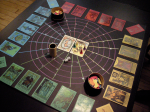
Fortuna Rules Page 1, Fortuna Rules Page 2
The board game Fortuna mirrors the comedy of life. Using metaphors for life’s journey found in cultures across the globe, Fortuna puts players through the paces of navigating life’s ups and downs while on the path to wisdom and maturity. Decisions are influenced by a player’s ability to collect information, apply experience, influence others and weigh options. One’s path is determined both by the hand of Fate and responses to other players’ actions. Tarot Cards are incorporated into game play and the game board design to lend a sense of meaning and provide game play structure. Players navigate a maze-like board, acquiring gold nuggets and action cards along the way. The first player to acquire 5 action cards and arrive at the board terminus wins the game.
Horiball (Bounce A Ball Horizontally)
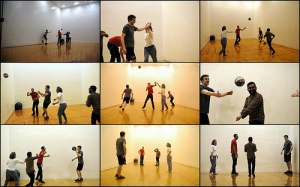
Horiball Rules
Horiball is a new sport, played on a racketball court with exercise balls and a kid’s rubber ball. The exercise balls act as goals positioned in diagonally opposite corners of the court. The players can only move the ball down the court horizontally (Hori-ball) using the court walls.
Water Works Wonders
July 2, 2009
An Experience & Exhibit Design
The American Museum of Natural History (AMNH) and partners (Minnesota Museum of Science, etc.) developed the exhibit “Water H2O = Life” to raise awareness of water quality and quantity issues around the globe. The attached slide show and supplementary documents present a concept for an Internet-connected road show based on the exhibit’s 10-year international travel schedule.
The Road Show Concept
Spurred by the exhibit itself, local organizations, artists and scientists will collaborate in presenting workshops during which the participants’ water-related stories are collected and distributed through an online community and presented as performance or in other means suitable to attract the attention of a local audience. Workshop curriculum and facilitator’s guides are developed for local interests to implement and distributed through the online portal. The road show design incorporates principles of hyperlocalism (global issues presented within the context of local agendas and needs), community arts movement (eco-arts, community building and empowerment, partnerships), and institutional branding (growing AMNH membership, making AMNH’s contributions to content and programming visible and secure).
Toy Emissary
July 2, 2009
Community Capacity Building
The Toy Emissary is a felt-covered box with switches and buttons that tempt the curious. The Toy delivers messages displayed on an adjacent computer screen; makes noises and lights LED. Messages entered from an accompanying keyboard by one person are retrieved by another person by playing with the switches in combination. The recipient can pass text back by doing the same.
This was the beginning of an exploration into how interactive media can be used to help engage and empower communities or individuals faced with solving ambiguous, complex or contentious/divisive issues. The idea is to provide a playful environment where conversations, imagination and out-of-the-box thinking is stimulated among people with diverse interests. The goal would be to create common ground, build trust and a sense of hope and unity as a precondition to tackling the difficult issues. The objects and their installations would provide a platform for sharing stories, images and information that daylight implicit values and investments that transcend differences within a community.
My Design Philosophy
In the course of systematic field study of museums and public space, review of scholarly literature regarding the learning process and experience design and through my design and collective storytelling projects, I have developed my own position regarding experience and exhibit design. After visiting places as diverse as the Brooklyn Botanical Gardens, the Tenement Museum, the City Museum of New York and National Park Visitor Centers and outdoor programs, many things came together for me while comparing my experience at the Children’s Museum of the Arts (CMA) in Manhattan and the NY Hall of Science. I have shared this comparison in a journal entry below along with the working draft of my Experience Design Manifesto.
Journal Entry
New York Hall of Science, Flushing, NY
Children’s Museum of the Arts (SOHO Children’s Museum), Manhattan
While the Hall of Science seemed to be analyzing wondrous things through the spectacle of the interactive, the Children’s Museum of the Arts (CMA) seemed to be instilling a sense of wonder through the spectacle of personal uncertainty, imagination and adaptability.
The CMA was about MAKING according to each kid’s own inspiration and imagination. In my mind, I contrasted this with other museum experiences. National Gallery of Art, as a child, was about listening to the docents and “behaving ourselves,” speaking in hushed whispers, following two-by-two in line. The NY Hall of Science was about diffusing excited energy, often running or loping from one interactive station to another, and DOING whatever the buttons and mechanical knobs allowed.
The CMA was about EXPRESSING. The only didactic presence was brief, step-wise instructions from ephemeral staff for making a self-portrait and for playing with the green screen; and signage stating the mission, which gave permission to all who entered to make this their own experience. Spontaneity and serendipity seemed to be the flavors of the day. I could see myself return, as a child, feeling safe to make whatever I liked without judgment. In contrast, the Hall of Science, while entertaining, was predictable.
These excerpts from a longer journal entry were prompted by four intense weeks of field trips and critical analysis of museums culminating in visits to the NY Hall of Science and Children’s Museum of the Arts. The full-length journal entry linked below goes beyond the required gestalt and observation to document what had become a rather personal reflection of museums and my experience of them. This topic goes to larger questions I am asking in reference to the work I hope to do after graduating in May 2009 from NYU’s Tisch School of the Arts’ Interactive Telecommunications Program. I intend to use principles of play, the field of service design and practices in interactive media in ways that empower people to express themselves, get things done in satisfying ways and see things with fresh eyes. I intend to help people work together creatively on complex, ambiguous and potentially divisive issues in order to meet challenging goals.
Full-Length Journal Entry
Experience Design Manifesto, Working Draft
The ListenUp Scarf
July 2, 2009
Wearable
For a young teenage girl, the ListenUp Scarf is a canvas for self-expression and a reminder of her community of support. The two scarves, the winter version wired with audio and the summer version wired with light components, help her explore different forms of self-expression and build her self-esteem. From the summer scarf, LED lamps magically produce a gentle glow as night falls, a reminder that she can light up a room with her personality. With the winter scarf, she collects snippets of conversations with the scarf and shares them in unconventional ways. Because this scarf is all about voice, she will always think of it as a metaphor for speaking her truth. The scarves harken to her childhood security blanket while helping her grow into her next skin — that of a confident young woman.
The winter scarf is equipped with hacked Radio Shack 20-second audio modules controlled from an Arduino LilyPad microprocessor. Two soft-switches are dedicated to record and playback functions, respectively. Soft circuit technology is used to position the switches in one end of the scarf and the speaker and microphone in the opposite end. The summer version is equipped with solar powered, nocturnal LED pummers (BEAM circuitry). A pink and green palette is carried across lightweight fabric for summer and fleece for winter. Ornamentation includes charms that spell out “SPEAK” and “LISTEN,” matching tassels and trimming.
Shrek™ Matching Game
July 2, 2009
Assistive Technology
An existing Shrek Matching Game was modified for blind and visually impaired children by utilizing game piece shapes for tactile recognition and audio clips to guide activities. Each game piece is assigned a unique resistor value soldered to a radio jack, which when disconnected cues up the sound clips announcing a match or instructing the child to try again or restart the game. Sound clips are stored in a Processing programming environment and accessed using the Minum library.
